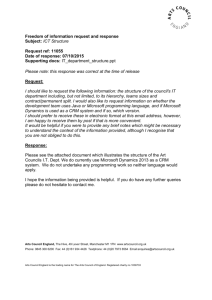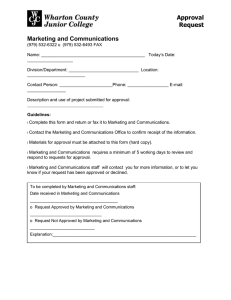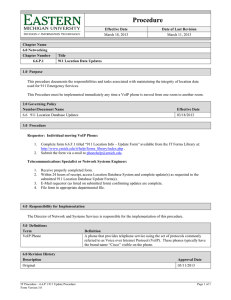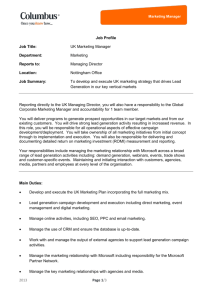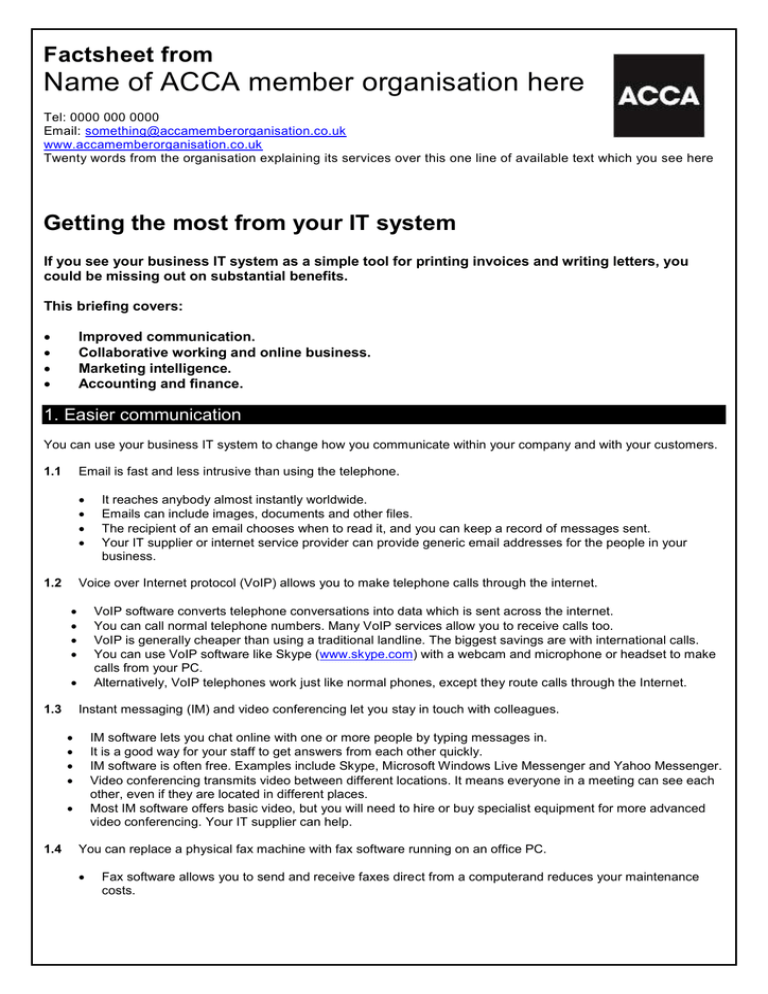
Factsheet from
Name of ACCA member organisation here
Tel: 0000 000 0000
Email: something@accamemberorganisation.co.uk
www.accamemberorganisation.co.uk
Twenty words from the organisation explaining its services over this one line of available text which you see here
Getting the most from your IT system
If you see your business IT system as a simple tool for printing invoices and writing letters, you
could be missing out on substantial benefits.
This briefing covers:
Improved communication.
Collaborative working and online business.
Marketing intelligence.
Accounting and finance.
1. Easier communication
You can use your business IT system to change how you communicate within your company and with your customers.
1.1
Email is fast and less intrusive than using the telephone.
1.2
Voice over Internet protocol (VoIP) allows you to make telephone calls through the internet.
VoIP software converts telephone conversations into data which is sent across the internet.
You can call normal telephone numbers. Many VoIP services allow you to receive calls too.
VoIP is generally cheaper than using a traditional landline. The biggest savings are with international calls.
You can use VoIP software like Skype (www.skype.com) with a webcam and microphone or headset to make
calls from your PC.
Alternatively, VoIP telephones work just like normal phones, except they route calls through the Internet.
1.3
Instant messaging (IM) and video conferencing let you stay in touch with colleagues.
IM software lets you chat online with one or more people by typing messages in.
It is a good way for your staff to get answers from each other quickly.
IM software is often free. Examples include Skype, Microsoft Windows Live Messenger and Yahoo Messenger.
Video conferencing transmits video between different locations. It means everyone in a meeting can see each
other, even if they are located in different places.
Most IM software offers basic video, but you will need to hire or buy specialist equipment for more advanced
video conferencing. Your IT supplier can help.
1.4
It reaches anybody almost instantly worldwide.
Emails can include images, documents and other files.
The recipient of an email chooses when to read it, and you can keep a record of messages sent.
Your IT supplier or internet service provider can provide generic email addresses for the people in your
business.
You can replace a physical fax machine with fax software running on an office PC.
Fax software allows you to send and receive faxes direct from a computerand reduces your maintenance
costs.
Microsoft Windows 7, XP and Vista have fax software built in.
Alternatively, you can use an online service like BT’s PC Fax (www.bt.com) or eFax (www.efax.co.uk). These
allocate you a fax number and allow you to send and receive faxes as attachments through email.
2. Working together
A basic network of PCs with internet access can help your staff work together more effectively.
2.1
You can allow your employees to share access to files and folders on your network.
2.2
Most operating systems, like Microsoft Windows, allow you to share files. If you have a network server, the
files can be stored there. Alternatively, you can share files saved on individual computers.
Sharing a single copy of a file means everyone has access to the latest version.
Rather than using email to update documents, changes and comments can be added to the master copy.
Some tools will allow you to plan, coordinate and track tasks and projects.
An online collaboration package puts all relevant project documents, plans and files in one place.
Everyone involved in projects can log in and check their tasks, send messages and update their progress.
These tools typically track document revisions and make it easy to roll back to a previous version.
If you have a network server, you can purchase and install your own online collaboration system. This needs
expert installation and can be expensive, but will give you maximum flexibility.
Company intranets often include collaboration features.
Alternatively, you can subscribe to a web-based collaboration package. These are accessed online, through
a normal browser.
Web-based packages include Basecamp (www.basecamphq.com), Huddle (www.huddle.net) and
activeCollab (www.activecollab.com).
3. Customer intelligence
With clever use of some simple tools, your customer database can become one of your most valuable business assets.
3.1
Use a spreadsheet to track new prospects and existing customers.
3.2
A customer database will give you much more flexibility, allowing you to store more information about each
customer, and making it easier to search.
3.3
You can create a spreadsheet using software like Microsoft Excel. This is a very basic way to store
information about your customers.
It is easy to add information about each customer or prospect as you contact them.
You may wish to include contact details, the date you last spoke to the customer and any other useful notes
to help you or your staff.
As your customer base grows, your spreadsheet will become unwieldy. There is only limited space for
information.
You can use software like Microsoft Access to create a central customer database.
By storing the database on your network server, you can give access to any member of staff who needs it.
Make sure you plan your database carefully, taking into account your present and likely future needs. You
may wish to store customer contact details, order history, order value, contacts with the customer and more.
A customer relationship management (CRM) system will allow you to track every contact your business has
with each of its customers. CRM packages include ACT! (www.act.com) and Salesforce CRM
(www.salesforce.com/crm) and can cost from £100.
Setting up a database or CRM system takes time. It is worth seeking expert help to ensure your database fits
your needs.
Use your database to identify what your customers are interested in and what they buy.
2
Your database software should be able to select customers according to criteria that you specify. For
example, people who have bought in the past three months.
Mailshots targeted at specific types of customer can be more successful than blanket campaigns (see 4.1).
4. Marketing
Even a basic IT system opens up new marketing opportunities for your business.
4.1
Send out email newsletters to people who sign up through your website.
4.2
You can use standard email software to send an email to a small number of customers.
For a larger customer database (more than 20), you will need to use specialist mailing software.
Give great presentations.
4.3
Presentation software allows you to create slideshows containing text, images , video and sound. Used
properly, these can inject interest into a pitch to prospective customers.
When creating presentations, resist the temptation to cram lots of information into each slide. Focus on the
key points.
Use a mail merge to contact customers personally by post.
4.4
Most word processing packages have a mail merge function. This allows you to create a personalised letter,
leaflet or flyer to send to customers.
For instance, you can add the customer’s name, address, or a list of the products they’ve bought from you.
Ensure consistency with templates and standard company branding.
Your IT system can help ensure you use your company logo, colours and branding in a consistent way.
Office suites like Microsoft Office or Open Office allow you to create templates for common items. For instance,
you can build a letterhead, invoice and presentation template so all your literature and marketing material has
a consistent identity.
5. Track your finances
Your IT system makes it easier to stay on top of your cashflow, spot problems early, and identify inefficiencies.
5.1
You can track incomings and outgoings with one or more spreadsheets.
You can set up separate spreadsheets for your cashflow, sales ledger, purchase ledger and wages.
If you keep these up to date, they provide an easy way to check the financial health of your business.
5.2
For more advanced reporting and extra flexibility, you should consider accounting software.
5.3
Online banking can simplify your day-to-day cash management.
Online banking can reduce overheads in your business. For instance, you can save paperwork by paying
outstanding invoices by BACS transfer instead of using cheques.
6. Get your business online
Virtually every business benefits from having its own website.
6.1
How you build your website will depend on your needs and level of skill.
3
6.2
Building a website from scratch can be tricky if you do not have experience of writing website code.
Instead, it may be better to base your site on a template. Web design software often includes templates to
get you started, or you can purchase a template-based package from a web hosting company.
If you want an advanced website, commission a web designer to build it for you.
Opening an online shop can enable you to reach new customers and expand your business cheaply.
7. Getting help
Unless you are an expert, you are unlikely to get the best out of your IT system without help.
7.1
There are many places to look for help yourself.
7.2
You can usually get help from the hardware or software manufacturer, or your IT supplier.
7.3
Most mainstream software packages have built-in help. You can usually access it by pressing the F1 key.
Software publishers tend to offer additional support through their websites. Always try there if you have a
problem.
There is a wealth of information available on other websites and forums.
Try typing an explanation of the problem you are having into a search engine. The chances are that
someone, somewhere, has experienced the same issue before.
You may be able to call a support line for help.
For critical issues, considering calling out an engineer.
Get help early.
You can reduce future support costs by using an expert to set up your system.
Many businesses find help essential for setting up more complex programs such as databases.
Simple ways to make the most of your IT
It can be easier than you think to use IT in your business more effectively:
A
B
Search online to explore trends and gaps:
For a new angle on something, use a search engine. For instance, if you want new ways to market your business,
try searching for ‘unusual ways to market my business’.
This method is best used to spark thinking in new directions. Be wary of relying on unsubstantiated advice when
making important decisions.
Encourage your staff to share how they use IT.
Many businesses have a range of IT experience in-house.
If some of your employees are particularly IT literate, encourage them to help other members of staff and make
sure everyone has enough time to get to grips with new software and procedures.
Experts’ quotes
"Many businesses are not aware of the full capabilities of a modern multifunction printer (MFP) and the advantages of a
digitalised document flow. For example, scanning a document to PDF and sharing it with colleagues via email directly
from the device is a function most MFPs offer that saves office workers time and paper.
More advanced MFPs can be combined with a software platform like EIP (Extensible Interface Platform) that
allows independent software vendors and developers to easily create personalised and customised document
management solutions that users can access directly from the MFP touch screen. These solutions can leverage
businesses’ existing infrastructure and databases.”
Mark Duffelen, Xerox Office Group
4
Expert contributors
Thanks to Mark Duffelen (Xerox Office Group, 01895 251133, www.xerox.com).
Further Help
Last reviewed 01.02.11
© BHP Information Solutions Ltd 2011. ISSN 1369-1996. All rights reserved. No part of this publication may be reproduced or transmitted without the
written permission of the publisher. This publication is for general guidance only. The publisher, expert contributors and distributor disclaim all liability
for any errors or omissions. Consult your local business support organisation or your professional adviser for help and advice.
5

